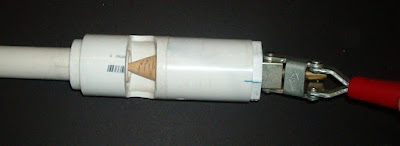Here is another fun lathe project that I did and unlike the Multicenter Lathe Statue this one has some actual practical use! I decided after some suggestions by Otto Jr. and Matt Mylar that I should try my hand at making some tops on my Homemade Wood Lathe. The top was a pretty straightforward project with the only really tricky part being the metal point at the tip that the top spins on.
The above picture is how the top turned out on the lathe (pun intended). The wood that I used is one of my favorite types to use for turning practical stuff - bamboo. These days you can go to the local discount store and get laminated bamboo cutting boards for cheap. There are also some expensive ones out there that you can get that have some advantages that I'll mention. These boards are made up of small pieces of bamboo that have been machined smooth into strips and then the strips glued into a board. I have found bamboo to be a relatively easy wood to work with that has basically no grain and is easy to sand. Although when sanding bamboo (or anything for that matter) make sure you have some dust management system and wear a face mask. The difference between the cheap boards at the discount store and the more expensive ones is the cheap ones tend to have voids and empty spaces inside them in random places. You can't see the voids until you cut into it but be aware that they might be there if you decide to chop up your bamboo chopping block.
So after getting the bamboo boards I got a hole saw and cut small discs out of the them . Then I glued all the discs together into stacks. I drew black lines on each disc to show where the grain direction was and made sure that when gluing the stacks together the black lines didn't line up. In this way the grain is at right angles in each layer. It's actually a bit more complicated because the cutting board alternates layers of bamboo and those are also at right angles... but simply put they are not lined up.
In order to mount the stacks on the lathe I had to glue each stack onto a piece of base wood that I could use to mount to the lathe spindle. In the above picture there are two stacks glued and dried with one on the lathe.
Turning the top down to the classic top shape was easy and a lot of the fine shaping I did with a wood rasp. The lathe gouge is handy for big cuts but finer detail is easier if you use a file or rasp and essentially power sand/file it into shape. A measured drawing of this project is available upon request if you want to know the shape!
Once the shape is right sanding and waxing the top is next. To get the top off the base plate I just law a saw blade against the place I want to cut and turn the lathe on. I don't recommend anyone using a saw blade like that or a wood file to shape stuff on a lathe. Be safe and don't do what I do!
The point of the top I made with a screw that I glued into a small hole that I drilled in the end of the top. Onto the screw I threaded a small aluminum shoulder nut and glued that too. Again I grabbed the file and filed the screw to a point.
Tops are fun if you can figure out how to wind the string onto them and throw them. Some people are good at it and others not so good. I am better at making tops than throwing them I think.
Tops when left alone like to conversate amongst themselves as shown in the above picture. Leave them alone while they are conversating or until the urge to throw one becomes too great and you must do it. If this is the case use caution when approaching the tops and it's wise to make a low whistling or humming sound as you approach so as not to surprise them. Stampeding tops can be dangerous as they have a sharp point on one end (the bottom).
The picture above shows a bit of the point that is made from a filed down screw and the aluminum shoulder nut. The shoulder is important to keep the string from falling off the top as you wind it. I did consider making that shoulder on the lathe from wood and just put a metal point in it but I didn't think that it would be strong enough. Repeated throws and impacts with cement or roadway and it would be chipped and broken off.
There you have it:
- The Low Down on the Homemade Top -







































